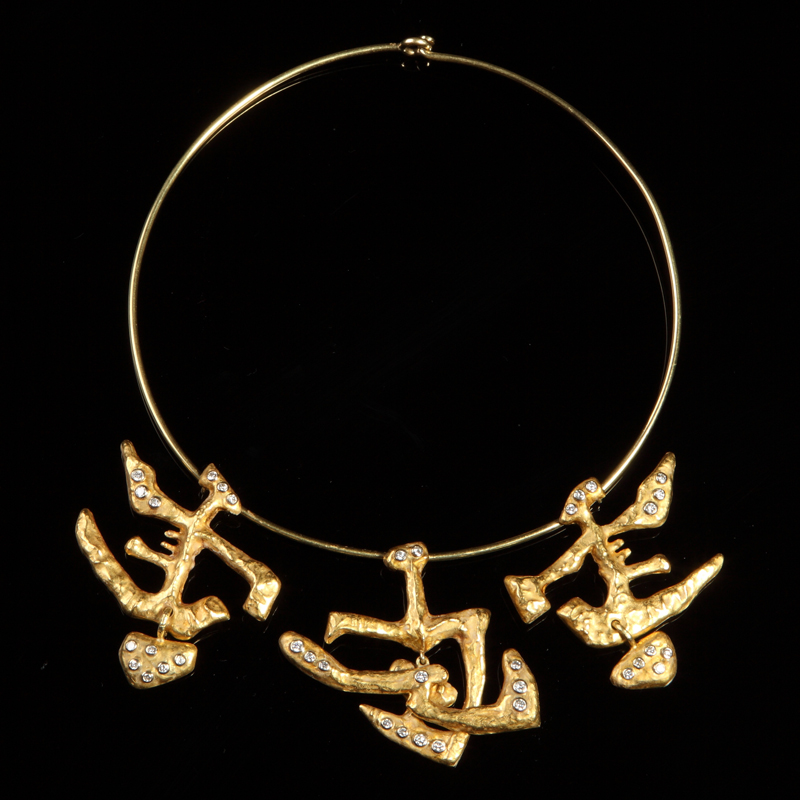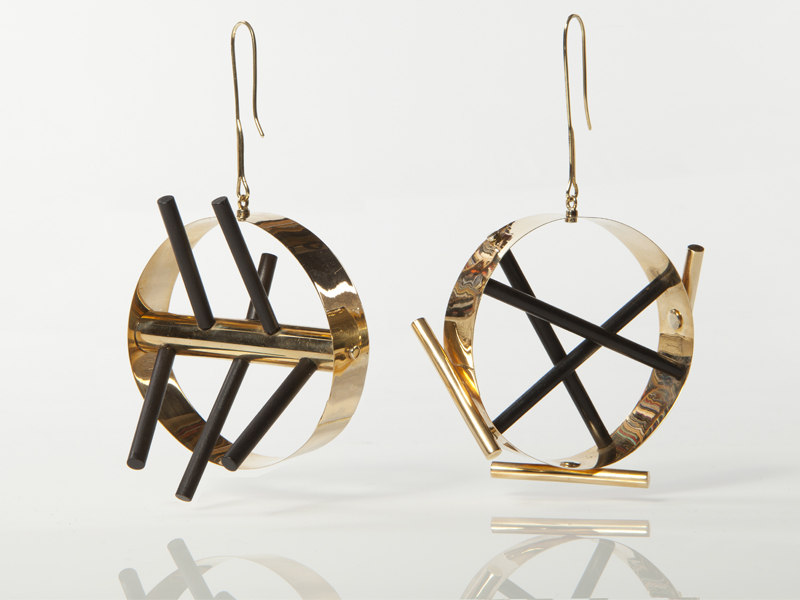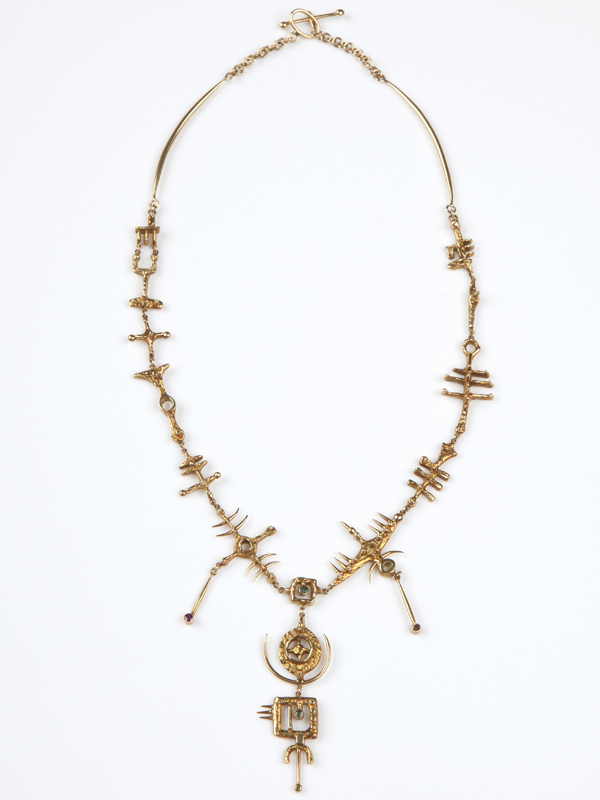
Didier and Martine Haspeslagh developed their gallery exhibitions around jewelry by artists and mid-century jewelers. Didier Ltd shows at fairs all around the world, including the TEFAF (The European Fine Art Fair) in Maastricht, Netherlands, the Spring Masters show in New York, and the Masterpiece show, which is currently on in London. They are incredibly knowledgeable, do research on this work, publish catalogs about various groupings, and move the market along for this work. More recently, they have begun to show jewelry that crosses over with the late 20th-century jewelers more familiar to readers of this website.
Susan Cummins: Didier and Martine, you work together in the gallery and in life. What are your backgrounds?
Didier Haspeslagh: I have been an antiques dealer for 35 years, coming to London in 1979 to work as a porter at Christie’s for two years while trading at flea markets (Camden Lock and Camden Passage) on the weekends. Then I opened up a booth in an antiques mall in Kensington Church Street selling 20th-century design jewelry and silver wares, originally concentrating more on Art Nouveau, Arts & Crafts, and Art Deco, but gradually buying more modern pieces and especially those by painters and sculptors that were available on the secondary market. Then five years ago, with the move to our own gallery further up Kensington Church Street, we made the conscious decision to concentrate on artist jewels and the best post-war studio jewelers/designers.
Martine Haspeslagh: I trained as an archaeologist with a specialty in ancient Roman and antique glass, although I grew up in a 15th-century home filled with modern design; my father was a leading structural engineer who had, as a younger man, worked for Ray and Charles Eames and Eero Saarinen, and my mother was an art historian, so I have always been interested in both art and design and the social history behind it.

You have a London gallery location showing mid-century artists who made jewelry, like Calder, for example. How did you develop this specialty?
Didier Haspeslagh: I have always loved modern art, visited exhibitions, and read widely about it, building up a large reference library, but I have never been able to afford it. Buying the jewelry, however, enabled us to acquire our own changing art collection in miniature, which Martine enjoys wearing and I like looking at.
At the TEFAF fair in March, you gathered together the work of Italian masters from the 1940s to the 1990s for a show called Jewels of the Italian Modern Masters, and now you are continuing to show that work at the Masterpiece show in London . How long did it take to gather this collection and where did it come from?
Didier Haspeslagh: The first pieces were probably acquired 10 years ago, but about two years ago, after doing an exhibition for Design Basel on the jewels of Arnaldo and Gio Pomodoro, we thought we could expand to include other Italian artists using pieces we already had, and then acquire more with this new exhibition in mind. Then, as if by osmosis, we have been offered the most wonderful pieces, including—the day the catalogue was meant to go to press—a headband by the portrait artist Piero Annigoni that he made for his then-muse Juanita Forbes in 1955. The week before, we were offered a bracelet by Franco Cannilla and a collar by Edgardo Mannucci.

Have you seen a big change in the prices of mid-century jewelry in the past few years? What do you think is affecting the market?
Didier Haspeslagh: Indeed, yes. There is a new generation of art and jewelry collectors who appreciate the connection between art and design, while older collectors of contemporary design are also beginning to look at acquiring the early pieces by their favorite artists and designers, which are now returning to the market. Exhibitions like Diane Venet’s Picasso to Koons: The Artist as Jeweler that was on at the MAD museum in New York and Bass Museum in Miami Beach have also helped raise awareness. It is becoming a popular collecting field with a resulting steady rise in prices, so much so that for some pieces that were made in limited editions we now have to pay more for the next example than we sold the last one for. Prices have doubled over the last four years, while prices for Calder and Dali at auction have run away with new very serious and deep-pocketed collectors entering the field.

Do you think there is a difference in quality or feeling between the work commissioned by famous artists like Picasso, Dali, and Arp and made by skilled goldsmiths, and that made by the hands of the artists like Calder or Martinazzi?
Didier Haspeslagh: There is no straight answer for this. For us, on the one hand we admire the work of sculptors like Calder and Bertoia, where the skilled hand of the metal artist is very much in evidence, while sculptors like Martinazzi and both Pomodoro brothers, who started off as jewelers, produce gold work of the highest craftsmanship. Painters like Picasso, Arp, and Dali all need the help of a goldsmith to turn their designs into jewels. Picasso turned to the goldsmith François Hugo, who worked with a number of artists including Arp, Derain, and Cocteau in the south of France in the 1960s and 1970s. Heger de Lowenfeld was called by Georges Braque “the extension of my hands.”
In our exhibitions it is possible to see the various different levels of personal involvement in the creation of jewels. There are jewels created fully by the artist themselves and, being Italian, they were all seduced by working in gold, with those made by Arnaldo and Gio Pomodoro reusing the ancient technique of cuttlefish bone casting that they also used in their earliest sculptures. Other artists, like Giacomo Manzu and Bruno Martinazzi, also reveal themselves to be excellent goldsmiths, which is in sharp contrast to their American contemporaries who preferred to work in bronze, brass, or silver. There is also a group of jewels, made in Rome during the 1950s and 1960s, designed by artists such as Afro Basaldella, Lorenzo Guerrini, and Franco Cannilla, who were involved personally in embossing or otherwise decorating their pieces in the gold workshops of Mario Masenza, while his workmen then finished them off with the necessary clasps and hinges, etc. At the end of the 1960s, Giancarlo Montebello set up GEM Montebello to produced limited editions much as François Hugo had done before, but, unlike Hugo, Montebello worked much more closely with the artist, and through their mutual respect and understanding, rough preparatory sketches were transformed into elegant jewels of the greatest craftsmanship that are still immediately recognizable as that specific artist’s work.
You show at a lot of fairs internationally. What is your next stop, and where else will you be this year?
Didier Haspeslagh: Our next show is going to be SOFA in Chicago in early November, where we will be concentrating more on American artists and the best of our vintage studio designers. After that we are going to Theta in Houston, where we shall be concentrating on the Italian Masters. We will concentrate on them as well again at the Winter Antiques Show in New York in January and the Palm Beach Show in February. For TEFAF next year, we will be presenting our collection of artist and designer rings.
Thank you.

Index Image: Giorgio de Chirico, Cavallo e Cavaliere con Beret to Frigio, circa 1950, pin, 18-karat gold, embossed, height 68 mm, 45 mm wide, photo: Didier Ltd




